Through the Fire and the Flood–The Texas A&M VET Serves Texas Communities
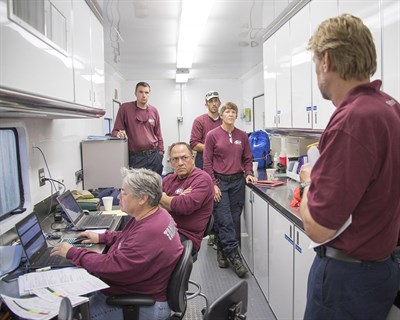
Early June 2016 brought devastating floods and tornadoes to southeast Texas. In emergency situations such as these, it is important to have safe and efficient evacuation plans prepared for our communities, including our family pets and livestock. Just like people, animals need care and shelter when a disaster strikes, and the Veterinary Emergency Team (VET) at the Texas A&M College of Veterinary Medicine & Biomedical Sciences (CVM) is there to provide such care.
“We are Aggies,” said Dr. Wesley Bissett, the executive director of the VET. “Aggies do special things in tough times, they stand up and serve.”
The VET was a dream brought to life in response to Hurricane Ike in 2008. After Hurricanes Katrina and Rita hit the Gulf Coast in 2005, Bissett noticed that the care of animals in disasters was practically nonexistent. Many disaster victims were not willing to evacuate because they couldn’t take their pets with them. They often stayed in place to protect their pets, putting their own lives at risk.
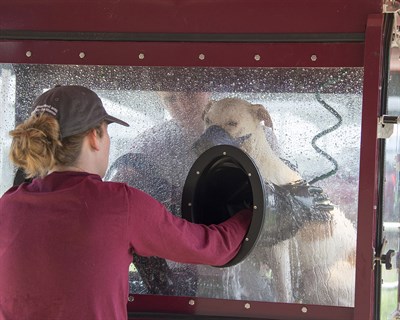
In 2006, the Pets Evacuation and Transportation Standards (PETS) Act was passed at the federal level and required communities to have a plan for the evacuation of people with their animals during emergencies. The passage of PETS motivated Bissett to begin forming a veterinary emergency response team in 2008 at the CVM.
The VET was fully established in 2009. Since proving their effectiveness in the 2011 wildfire disaster in Bastrop, the VET has expanded to over 30 dedicated veterinarians, veterinary technicians, volunteers, and Texas A&M faculty, students, and staff. In addition, the VET also allows veterinary students a unique opportunity for field experience and is a required rotation in veterinary school at Texas A&M, something unique to the CVM.
“The bulk of the team is primarily faculty and staff that volunteer their time to be there,” said Angela Clendenin, public information officer for the VET. “However, students participate in a two-week rotation called Community Connections, which is taught by the faculty members on the VET. When there’s a disaster, we are able to take students that happen to be on the Community Connections rotation if they are able to go. Some of them have obligations that preclude them from going, and it’s not mandatory that they deploy with us, but they are encouraged to go and share in that experience.”
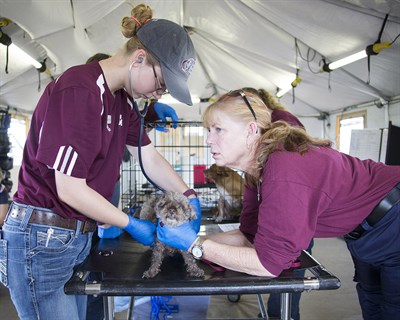
The program is unique because students’ experience with disaster relief goes beyond theoretical knowledge. Instead, they learn first-hand about animal issues in disasters. When there’s not a disaster, the students work with faculty, local governments, and communities around the state of Texas to develop evacuation, sheltering, and medical operations plans for animals impacted by disasters.
Working out of several trailers and tents when on duty, the team has worked hard to secure equipment to serve their needs since its formation. It can be hard to anticipate the condition of animals when a disaster strikes; therefore, the team has developed special equipment, including a decontamination unit, to aid in the recovery of wounded or sick animals.
In June 2016, special equipment, like the decontamination unit, played a key role in treating animals affected by the flooding in Fort Bend and Brazoria Counties in southeast Texas. The portable decontamination unit, which helps VET members safely remove bacteria and debris from animals, allowed animal victims to be placed in a shelter or back in the homes of their families. The VET was deployed to the two counties and spent two weeks treating more than 100 animals—including livestock, cats, ducks, horses, and dogs—in the flooded community. Along with decontaminating animals that may have come into contact with toxic chemicals in the flood water, the team treated many other conditions, such as dehydration and submersion injuries.
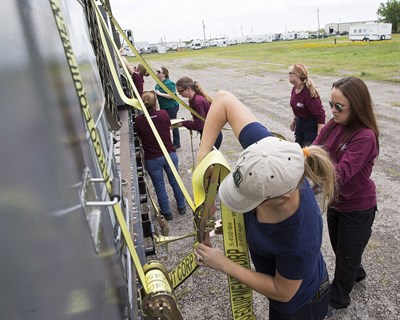
Students say they found the experience rewarding and eye-opening. “Spending my time in Brazoria County was such an unforgettable experience. I gained so much knowledge in veterinary medicine from my time there,” said Heather Cook, a fourth-year veterinary student at the CVM. “The first couple of days I was deployed, I worked with small animals because I am focusing on small animal medicine. I gained a lot of experience performing physical examinations on dogs and cats, coming up with my own diagnoses and treatment plans. I also talked with clients about spaying, neutering, and vaccinating their pets, as well as putting them on heartworm and flea and tick prevention.”
When deployed by the state or county, the VET works with the county’s local veterinarians for extra supplies. AgriLife Extension is also included in the relief efforts to care for livestock, and shelters make sure the animals are kept safe and healthy until they can be returned to their owners.
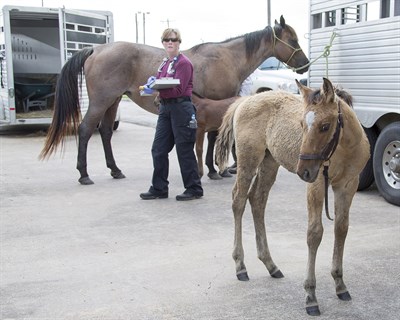
“It’s a large group effort that we try to bring together. Linking with local veterinarians is crucial,” explained Dr. Deb Zoran, medical operations officer for the VET. “In Brazoria County, the local veterinarians came out to our base of operations and would bring things that we needed, such as supplies and equipment. They were out there almost every day, checking on us to make sure we were okay. The relationship between our team and local veterinarians is vital to our success.”
The VET’s formation was a result of Bissett’s dream and a group of passionate, caring Aggies who wanted to make a difference for people and their pets during emergency situations. The PETS Act of 2006 solidified the need for animals to be cared for in disasters, and the VET’s proven effectiveness led to the team’s expansion. Now, as one of the most seasoned veterinary emergency response teams in the country, the VET has demonstrated time and time again that it can be counted on to care for animals in crises.


